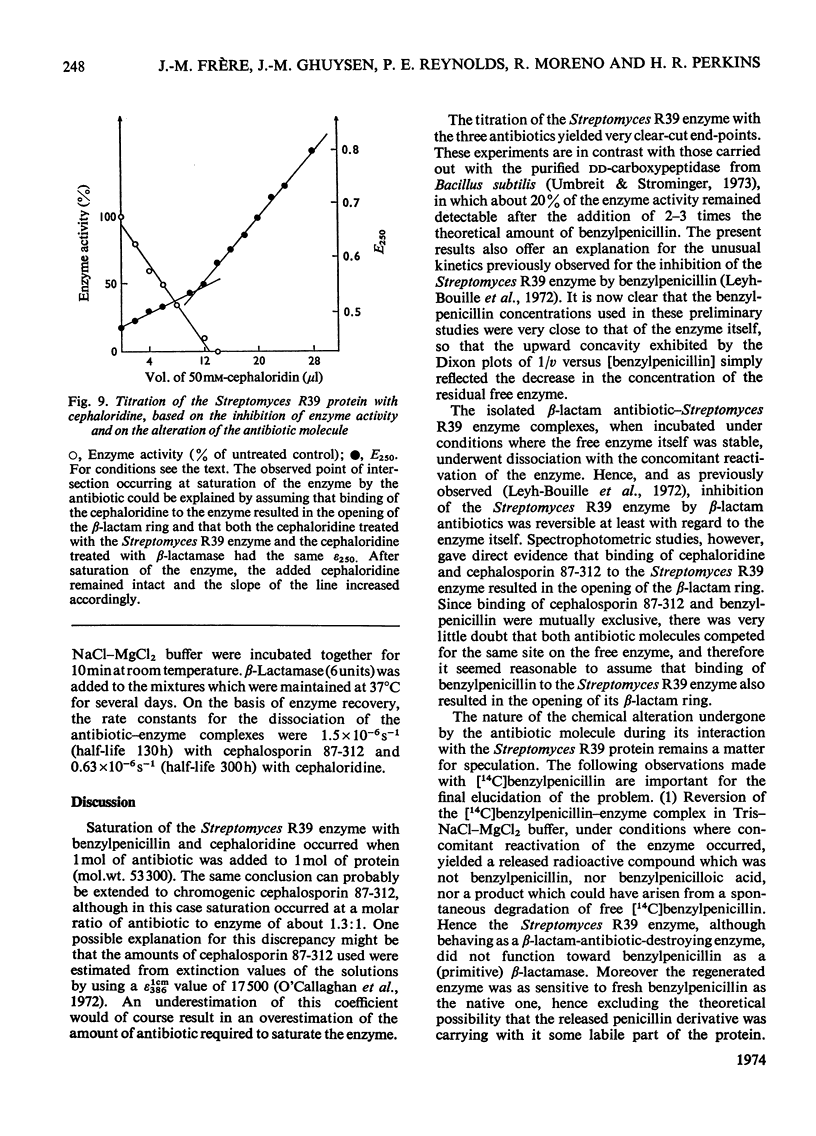Abstract
Benzylpenicillin and cephaloridine reacted with the exocellular dd-carboxypeptidase–transpeptidase from Streptomyces R39 to form equimolar and inactive antibiotic–enzyme complexes. At saturation, the molar ratio of chromogenic cephalosporin 87-312 to enzyme was 1.3:1, but this discrepancy might be due to a lack of accuracy in the measurement of the antibiotic. Spectrophotometric studies showed that binding of cephaloridine and cephalosporin 87-312 to the enzyme caused opening of their β-lactam rings. Benzylpenicillin and cephalosporin 87-312 competed for the same site on the free enzyme, suggesting that binding of benzylpenicillin also resulted in the opening of its β-lactam ring. In Tris–NaCl–MgCl2 buffer at pH7.7 and 37°C, the rate constants for the dissociation of the antibiotic–enzyme complexes were 2.8×10−6, 1.5×10−6 and 0.63×10−6s−1 (half-lives 70, 130 and 300h) for benzylpenicillin, cephalosporin 87-312 and cephaloridine respectively. During the process, the protein underwent reactivation. The enzyme that was regenerated from its complex with benzylpenicillin was as sensitive to fresh benzylpenicillin as the native enzyme. With [14C]benzylpenicillin, the released radioactive compound was neither benzylpenicillin nor benzylpenicilloic acid. The Streptomyces R39 enzyme thus behaved as a β-lactam-antibiotic-destroying enzyme but did not function as a β-lactamase. Incubation at 37°C in 0.01m-phosphate buffer, pH7.0, and in the same buffer supplemented with sodium dodecyl sulphate caused a more rapid reversion of the [14C]benzylpenicillin–enzyme complex. The rate constants were 1.6×10−5s−1 and 0.8×10−4s−1 respectively. Under these conditions, however, there was no concomitant reactivation of the enzyme and the released radioactive compound(s) appeared not to be the same as before. The Streptomyces R39 enzyme and the exocellular dd-carboxypeptidase–transpeptidase from Streptomyces R61 appeared to differ from each other with regard to the topography of their penicillin-binding site.
Full text
PDF








Selected References
These references are in PubMed. This may not be the complete list of references from this article.
- Frère J. M., Ghuysen J. M., Perkins H. R., Nieto M. Kinetics of concomitant transfer and hydrolysis reactions catalysed by the exocellular DD-carboxypeptidase-transpeptidase of streptomyces R61. Biochem J. 1973 Nov;135(3):483–492. doi: 10.1042/bj1350483. [DOI] [PMC free article] [PubMed] [Google Scholar]
- Frère J. M., Moreno R., Ghuysen J. M. Molecular weight, amino acid composition and physicochemical properties of the exocellular DD-carboxypeptidase-transpeptidase of Streptomyces R39. Biochem J. 1974 Oct;143(1):233–240. doi: 10.1042/bj1430233. [DOI] [PMC free article] [PubMed] [Google Scholar]
- Ghuysen J. M., Leyh-Bouille M., Campbell J. N., Moreno R., Frére J. M., Duez C., Nieto M., Perkins H. R. Structure of the wall peptidoglycan of Streptomyces R39 and the specificity profile of its exocellular DD-carboxypeptidase--transpeptidase for peptide acceptors. Biochemistry. 1973 Mar 27;12(7):1243–1251. doi: 10.1021/bi00731a001. [DOI] [PubMed] [Google Scholar]
- Ghuysen J. M., Reynolds P. E., Perkins H. R., Frère J. M., Moreno R. Effects of donor and acceptor peptides on concomitant hydrolysis and transfer reactions catalyzed by the exocellular DD-carboxypeptidase-transpeptidase from Streptomyces R39. Biochemistry. 1974 Jun 4;13(12):2539–2547. doi: 10.1021/bi00709a010. [DOI] [PubMed] [Google Scholar]
- Leyh-Bouille M., Nakel M., Frère J. M., Johnson K., Ghuysen J. M., Nieto M., Perkins H. R. Penicillin-sensitive DD-carboxypeptidases from Streptomyces strains R39 and K11. Biochemistry. 1972 Mar 28;11(7):1290–1298. doi: 10.1021/bi00757a027. [DOI] [PubMed] [Google Scholar]
- Marquet A., Dusart J., Ghuysen J. M., Perkins H. R. Membrane-bound transpeptidase and penicillin binding sites in Streptomyces strain R61. Eur J Biochem. 1974 Aug 1;46(3):515–523. doi: 10.1111/j.1432-1033.1974.tb03645.x. [DOI] [PubMed] [Google Scholar]
- Nieto M., Perkins H. R., Frère J. M., Ghuysen J. M. Fluorescence and circular dichroism studies on the Streptomyces R61 DD-carboxypeptidase-transpeptidase. Penicillin binding by the enzyme. Biochem J. 1973 Nov;135(3):493–505. doi: 10.1042/bj1350493. [DOI] [PMC free article] [PubMed] [Google Scholar]
- O'Callaghan C. H., Morris A., Kirby S. M., Shingler A. H. Novel method for detection of beta-lactamases by using a chromogenic cephalosporin substrate. Antimicrob Agents Chemother. 1972 Apr;1(4):283–288. doi: 10.1128/aac.1.4.283. [DOI] [PMC free article] [PubMed] [Google Scholar]
- Perkins H. R., Nieto M., Frére J. M., Leyh-Bouille M., Ghuysen J. M. Streptomyces DD-carboxypeptidases as transpeptidases. The specificity for amino compounds acting as carboxyl acceptors. Biochem J. 1973 Apr;131(4):707–718. doi: 10.1042/bj1310707. [DOI] [PMC free article] [PubMed] [Google Scholar]
- Schwartz M. A. Catalysis by poly-L-lysine of aminolysis of penicillin by tris(hydroxymethyl)aminomethane. J Med Chem. 1969 Jan;12(1):36–38. doi: 10.1021/jm00301a009. [DOI] [PubMed] [Google Scholar]
- Umbreit J. N., Strominger J. L. D-alanine carboxypeptidase from Bacillus subtilis membranes. II. Interaction with penicillins and cephalosporins. J Biol Chem. 1973 Oct 10;248(19):6767–6771. [PubMed] [Google Scholar]


